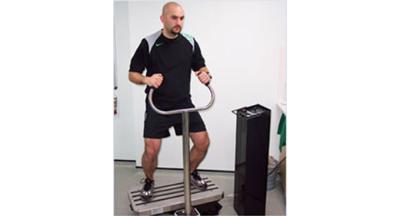Astronauts lose between one and two percent of their bone every month they spend in space, and this is one of the major problems of space travel. During space flights lasting longer than one month, astronauts undergo significant losses of bone mass and ‘bone mineral density’ in the weightbearing areas of the skeleton, particularly the spine and lower limbs.

Adam Hawkey, Senior Lecturer in Biomechanics, has researched the impact of vibration platforms on bone loss, and has been invited to present a workshop on vibration training at the 59th International Astronautical Congress (IAC).
Adam will explain how his research into vibration training could help to prevent osteoporosis on earth, but also help astronauts get to Mars by reducing the amount of bone they lose during the journey to and from the Red Planet, which is of particular concern to organisations like NASA and the European Space Agency. Adam has worked with NASA in the past on crew health issues during shuttle missions to the International Space Station.
Throughout the course of the five-day space extravaganza, Adam will be demonstrating how the vibration technology works and giving visitors the opportunity to experience the technology first hand.
“The event will be the ideal venue for me to showcase my research and ignite enthusiasm about human spaceflight to visitors from the UK and all over the world. At the event, I will be demonstrating how the vibration technology works and giving visitors the opportunity to experience the technology first hand.”
The conference takes place at the Scottish Exhibition & Conference Centre in Glasgow from the Monday 29 September to Friday 3 October 2008.
The IAC is the major international space conference of the year, and is hosted by the British Interplanetary Society. Its content provides overviews and in depth analysis of space exploration, space science and technology, applications and operations, economic benefits, social impact, challenges to progress and opportunities for international collaboration, as well as addressing more widely the history of spaceflight and its future potential.
Further information
Picture: Adam Hawkey demonstrates the vibration training
For media inquiries, contact Vickie Woodward in the Press Office on 01902 322736 or 07973 335112.


/prod01/wlvacuk/media/departments/digital-content-and-communications/images-2024/Diane-Spencer-(Teaser-image).jpg)

/prod01/wlvacuk/media/departments/digital-content-and-communications/images-18-19/220325-Engineers_teach_thumbail.jpg)

/prod01/wlvacuk/media/departments/digital-content-and-communications/images-2024/240509-Menopause-Research-Resized.jpg)

/prod01/wlvacuk/media/departments/digital-content-and-communications/images/Maria-Serria-(teaser-image).jpg)
